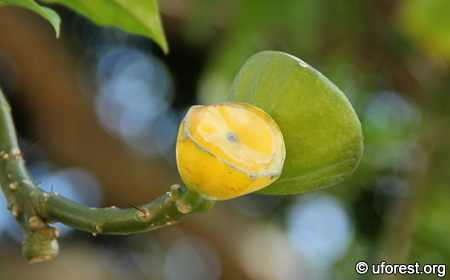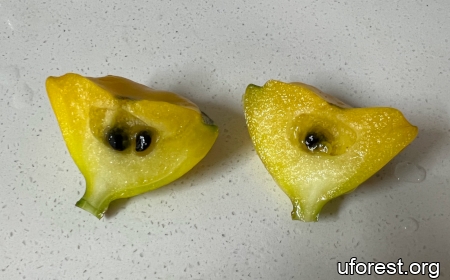Pereskia bleo (Kunth) DC.
| Etymology | Genus | After Nicholas Claude Fabry de Pieresc, a French botanist |
|---|---|---|
| Species | Unknown | |
| Family | Cactaceae | |
| Synonyms | Cactus bleo Kunth, Pereskia panamensis F.A.C. Weber | |
| Common Names | Rose Cactus, Leaf Cactus, Wax Cactus | |
| Status | Exotic: Cultivated Only | |
| Form | Shrub | |
| Native Distribution | Central America | |
Diagnostics:
This is a common shrub grown in private gardens for their purported medicinal properties. The stem is very spiny, the leaves have wavy margins and arranged spirally. It also flowers frequently, having rosy orange petals. The fruits are most peculiar, being funnel-shaped.
Interesting Facts:
The leaves of the Rose Cactus are eaten as they are believed to have anti-cancerous properties and also a relief from gastric pain (Globinmed, 2010). These were usually eaten raw or boiled in water and drunk (Zareisedehizadeh et al, 2022). Cytotoxic chemicals have also been isolated from its leaves (Malek et al., 2009).
The fruit is said to be edible, with soft moist flesh and a soury taste.

The Rose Cactus growing up to 5m in this church compound.

The stem is very spiny.

The leaves are arranged spirally.

The leaf with depressed veins and wavy margins.

The rosy orange flower.

The yellowish fruit has a peculiar funnel shape.

Sliced fruit with seeds.
References
Globinmed. (2010) Pereskia bleo (Kunth) DC. Global Information Hub on Integrated Science, Institute of Medical Research, Ministry of Health, Malaysia. http://www.globinmed.com. Accessed on 3-Jun-2013.
Malek SNA, SK Shin, NA Wahab & H Yaacob. (2009) Cytotoxic Components of Pereskia bleo (Kunth) DC. (Cactaceae) Leaves. Molecules, 14: 1713-1724.
Zareisedehizadeh S, Siew YY, Tan CH, Koh HL (2022) Medicinal uses of a leafy cactus, Pereskia bleo, in Singapore: A survey on the users' knowledge and their perceptions. International Journal of Herbal Medicine 10(1):1-7
Author: Siyang
Posted: 2013-06-03 / Modified: 2025-08-21